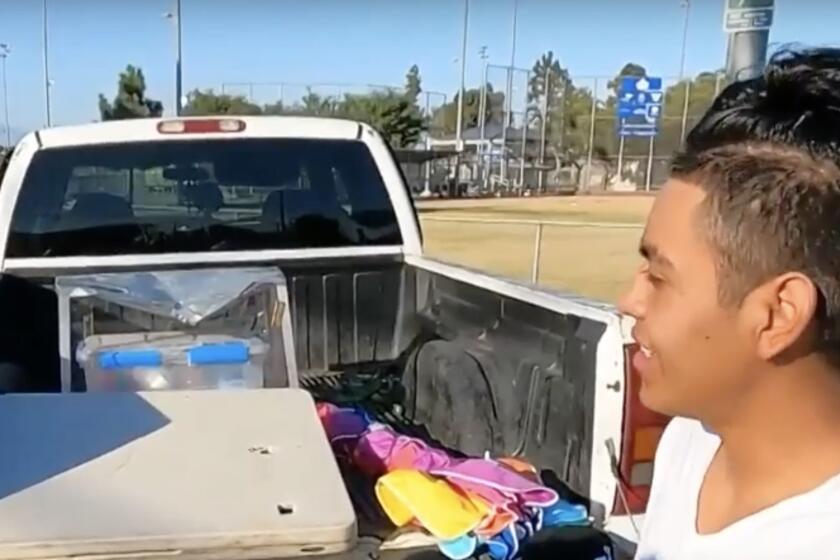Judge Bars New Coastal Oil Drilling
A federal judge effectively blocked new oil drilling off the California coast, ordering federal officials not to allow exploratory wells or other activity until they conduct a more extensive study of the environmental risks -- a process that could take years.
The federal government wants to extend leases on 36 offshore tracts between Oxnard and San Luis Obispo so that oil companies can turn them into working oil fields. State officials and environmental groups have been fighting the plan on several fronts. Friday’s ruling by U.S. District Judge Claudia Wilken came a day after the California Coastal Commission raised official objections to the same federal plan.
The judge’s ruling at a hearing Friday in Oakland came as a surprise to federal officials, who scrambled for clarification.
“We know we cannot move forward until additional environmental analysis has been conducted,” said John Romero, a spokesman for the Interior Department’s Minerals Management Service. “We don’t know exactly what that means.”
Meanwhile, lawyers representing 10 environmental groups that brought the lawsuit declared the ruling a major victory for those concerned about the risk of oil spills.
“This means our coast remains protected,” said Linda Krop, chief counsel of the Environmental Defense Center in Santa Barbara. “Nothing is going to happen for years.”
Even if the federal government appeals Wilken’s decision, no ruling would be likely until late next year at the earliest.
The court fight involves one of the few parts of the California coast that is not already off-limits to new oil drilling. The stretch of coastline includes 36 tracts off Ventura, Santa Barbara and San Luis Obispo counties that were leased to oil companies between 1968 and 1984 but never developed into undersea oil fields.
All of the leases were set to expire more than 15 years ago. But the Minerals Management Service has repeatedly extended them over state officials’ objections.
The 36 leases sit atop an estimated 512 million barrels of oil and have been the focus of regulatory and legal battles almost from the time they were first issued.
The companies that own the leases have filed their own lawsuit against the federal government, demanding that officials either allow them to drill or buy back the leases, which initially were purchased for $1.25 billion.
In a similar situation off the coast of Florida, the Bush administration in 2002 went along with a request by the president’s brother, Gov. Jeb Bush, and spent $235 million to buy back leases. The administration so far has declined to take similar action in California, where negotiations with the oil companies over the value of the leases have bogged down.
With talks over a buyout stalled, the action on drilling has mostly been in court. The first round came in 2001, when Wilken gave state officials a victory, saying they had the right to review and influence the extension of the leases. A federal law provides states the right to make sure federal actions do not run afoul of coastal protection laws. Wilken’s decision, which ordered federal officials to prepare an environmental analysis, was challenged by the Bush administration and upheld by the U.S. 9th Circuit Court of Appeals.
In February, the Minerals Management Service released its environmental analysis, concluding that extending the leases would cause no significant impact to the environment. Its analysis was narrowly focused on activities prior to drilling, such as surveying and finalizing plans. It did not examine environmental risks associated with the steps that would come next: exploratory drilling, building platforms and pumping oil.
Environmental groups sued, alleging that the federal analysis was too narrow to meet federal legal requirements. The lawsuit urged a full environmental impact statement that would include an examination of oil-spill risks and public hearings. The court assigned it to Wilken, who has become an expert in the area.
At Friday’s hearing, Wilken ruled that the analysis was incomplete and should include an assessment of any significant impacts related to future oil exploration and production.
She ruled from the bench after Drew Caputo, an attorney with the Natural Resources Defense Council, reminded her that the Minerals Management Service had indicated it might extend the leases as early as Monday. (The Bush administration had promised Gov. Arnold Schwarzenegger to hold off until then.) Wilken said her verbal ruling would be followed by a written opinion.
Romero said his colleagues want to review the ruling before the Interior Department decides its next move.
“We will be waiting for the written explanation from the court, which could take weeks or months,” he said.
Caputo said he hoped the U.S., after twice losing in court, would let the leases expire. If not, he said, any full-blown environmental impact statement would show the extensive risks to exposing the coast to additional oil drilling, oil platforms, oil pipelines or barges.
“There is a reason the federal government keeps doing this truncated environmental analysis,” Caputo said. “They don’t want to have to explain to everyone that there is a risk of a big oil spill, that a pipeline could burst, or other problems if they pursue oil development.”
California has active oil production on 43 offshore tracts in federal waters that are at least three miles from shore, and a few more in state waters. The platforms of these working wells dot the coastline off Huntington Beach, Long Beach, and Ventura and Santa Barbara counties. A number of these are edging toward a time when they will be decommissioned as their undersea oil fields are played out.
More to Read
Sign up for Essential California
The most important California stories and recommendations in your inbox every morning.
You may occasionally receive promotional content from the Los Angeles Times.










